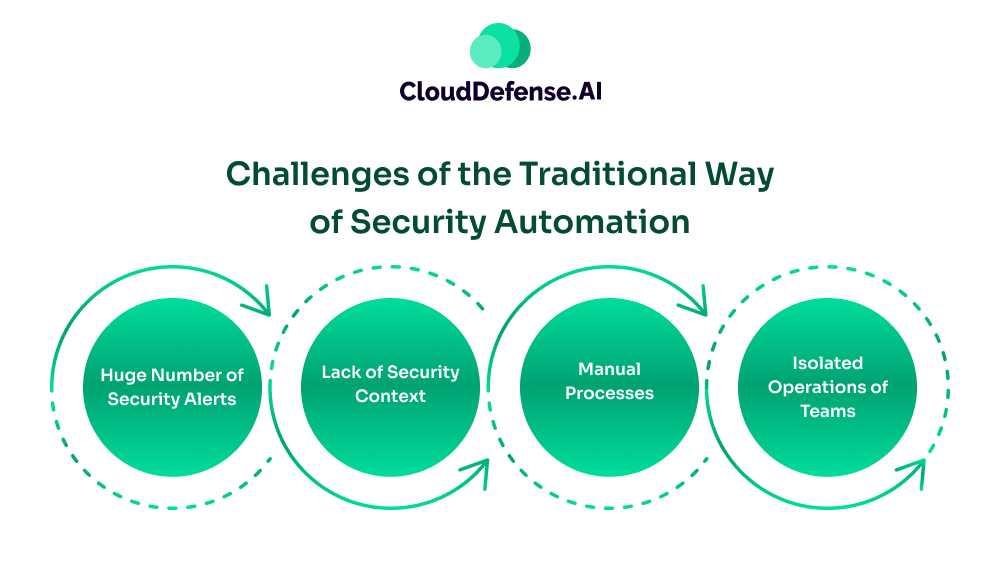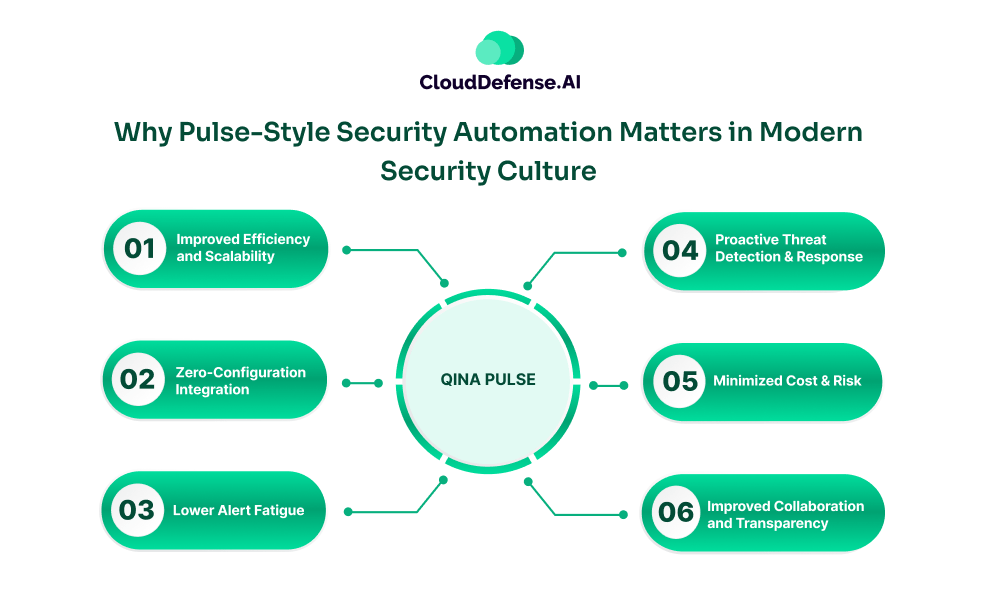With evolving cyber threats and a fast-paced development cycle, it has become a necessity for every organisation to maintain a balance. Security automation enables your developer and AppSec team to automate security tasks while ensuring high-velocity development. Despite all the automation, organizations often lag in terms of intelligent automation and optimized processes.
This is where QINA Pulse from CloudDefense.AI comes in. It serves as a revolutionary approach to security automation that utilises artificial intelligence to streamline all operations in application security. In this guide, we have pulse-style security automation explained and why it matters for your organisation.
Pulse-Style Security Automation Explained: Everything You Should Know
A pulse-style security automation is all about QINA Pulse integrating with your existing AppSec platform and security tools, simplifying all the security efforts. It serves as an advanced AI security assistant for your AppSec team and developers to help them with all the security tasks.
Pulse leverages the power of AI along with ML models to help your team automate security tasks with just a plain English command. You can consider it as a security copilot that performs the tasks by understanding the security context, business goal, and security processes. Moreover, it is constantly learning from feedback, AI models, and available information. As a result, it provides your team with actionable insight that your team can understand.
Traditional security automation tools are slow, lack context, and can be difficult to automate many security tasks. But QINA Pulse emerges as an intelligent security assistant that eliminates all the drawbacks of traditional tools. It helps automate all the tasks, ranging from threat detection, remediation, and creating tickets to generating compliance reports.
Pulse-style automation helps your AppSec team to bring down the hours of manual work to instant tasks. Now you won’t have to wait for hours; you just have to ask Pulse on the chat platform, and it will do the task for you. It not only transforms all the complex data but also reduces security workload and enhances developer efficiency.
What are the Key Features of Pulse-Style Security Automation

Pulse-style security automation is a key modern security automation revolution. It involves many vital features that help an organization to streamline all the security tasks and maintain an optimum security infrastructure. Here are the key features of Pulse-style security automation explained:
- English Language Queries: A key aspect of Qina Pulse automation is that it enables your AppSec team to make commands in plain English. Your team can ask anything, and Pulse will transform all the complex security data into an understandable insight. It prevents your team from looking for information by switching to different dashboards.
- Intelligent Alert Triage: Pulse by integrating into the AppSec platform provides the team with a prioritized security alert. It automates the process to assess, categorize, and prioritize all the security alerts based on security context, business goal, and available security information. It helps in reducing false positives and providing security teams and developers with high-impact vulnerabilities that require immediate remediation.
- AI-Backed Action: It acts as a security copilot for all the developers, enabling them to schedule security scans, orchestrate security workflow, and perform quick threat detection. It also enables the DevSecOps teams to create tickets for Jira or GitHub issues or send Slack notifications without getting involved in a manual step. Since it gets integrated with all the security tools, it can trigger any action in a few seconds.
- Real-Time Data Aggregation: When you introduce Pulse in your AppSec, it integrates with all the security tools and databases without requiring any complex configuration. This security copilot collects and assesses all the security data to provide a real-time data aggregation. Thus, it enables the security team to get an actionable insight from the complex security data and complete visibility into the overall security posture.
- Automated Remediation Action: Just by providing a command, the security and development team can initiate remediation action. Based on the vulnerability, Pulse by leveraging AI triggers pre-configured incident response actions. The action can be isolating the affected node or system, or deploying patches to quickly eliminate the threat.
- Continuous Compliance Monitoring: Qina Pulse automation enables your development and security teams to streamline all the compliance monitoring and checks. It also simplifies the process of compliance gap analysis and risk scoring. It automates the process to generate compliance reports, enabling your organization to stay compliant with regulations like GDPR, HIPAA, and PCI-DSS. For security audits, it also helps with rapid report generation and security analysis.
Challenges of the Traditional Way of Security Automation

We agree that traditional security automation is quite common and suitable for all business sizes. But it poses many challenges in today’s fast-paced development approach. These challenges are:
- Huge Number of Security Alerts: A major issue with traditional ways of security automation is that it generates a significant number of alerts, especially false positives. It not only causes alert fatigue in your teams but also leads to missing potential security threats. Moreover, it significantly increases the incident response time as teams have security triage for every alert.
- Lack of Security Context: Many security automation lack contextual awareness, thus they create vulnerability reports without any context or remediation steps. It forces the developers as well as security professionals to spend a lot of time analyzing the reports and understanding them. Importantly, these tools don’t transform the complex data into actionable insight. This often makes it difficult for developers to understand the complex security jargon, leading to a wastage of time.
- Manual Processes: Not all security processes can be automated with traditional AppSec platforms. Manual triage for alert prioritisation and generating security reports often bottlenecks incident response processes and hampers development cycles.
- Isolated Operations of Teams: In many instances, development and security teams work individually and don’t share any information through a real-time platform. They mostly depend on tickets to communicate for any security alerts. As a result, the teams are not able to communicate in real-time for security threats and maintain transparency in their remediation approach.
Why Pulse-Style Security Automation Matters in Modern Security Culture

QINA Pulse automation has become a need of the hour for modern organizations. It is a necessity for organizations that want to maintain optimum application security without hampering development speed. Here are some crucial factors that make it important:
- Improved Efficiency and Scalability: The improved efficiency and scalability are two of the key reasons that make this security copilot vital for organizations. It helps your team to automate most of the security tasks, like threat scanning and compliance gap analysis. This security copilot holds the capability to generate compliance reports within 30 seconds. Thus, it allows your teams to focus on other strategic tasks. Importantly, this tool can grow according to the volume of threats and security data. It maintains its security effectiveness even when the organization grows gradually.
- Zero-Configuration Integration: QINA Pulse is one of those tools that integrates with your existing AppSec platforms and tools seamlessly. It also offers one-click native integration with GitHub, Jenkins, Slack, and many others. A key aspect of Pulse-style security automation is that it scans for all the repositories, applications, and containers associated with your system. This enables it to offer accurate results based on your command.
- Lower Alert Fatigue: A key reason many enterprises are opting for Pulse-style security automation is that it provides prioritised security alerts. It performs intelligent triage based on various factors and highlights all the true security threats. All the false positives are filtered out in this process, enabling the development and security team to provide proactive incident response.
- Proactive Threat Detection and Response: QINA Pulse automation holds the capability to actively detect vulnerabilities and other threats within a few seconds. This security copilot works in conjunction with SAST, DAST, SCA, and other tools for proactive threat detection. It enables your team to offer quick incident response and automatically deploy remediation action.
- Minimized Cost and Risk: Pulse-style security automation is all about a proactive security approach, continuous compliance monitoring, and automated remediation. This automation of vulnerability management helps in addressing vulnerabilities before they can make an impact. It minimizes the chance of security breaches and the financial cost associated with them. Moreover, it constantly looks for gaps through constant compliance monitoring and saves the organization from hefty regulatory fines.
- Improved Collaboration and Transparency: Pulse, as an AI-security assistant, centralises all the security information in a single platform. It allows security teams across your organization to work on the same actionable intelligence and make a collaborative response to security threats.
Bottom Line
Pulse-Style security automation highlights the proactive and intelligent approach it brings to modern cybersecurity. By leveraging AI and intelligent automation, Pulse provides your team with a smart security copilot that accomplishes all security tasks with a simple English command.
Pulse helps you to go past the traditional automation way and adopt a cost-efficient approach that offers better application security. It not only helps you boost your guardrails against complex cyber threats but also improves developer efficiency and maintains quick software delivery. Take a first-hand experience with our free live demo of QINA Pulse and how it transforms your application security posture.







